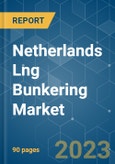The market was negatively impacted by the COVID-19 pandemic, as demand for LNG bunkering services fell as marine shipping and trade declined significantly. However, the market has since rebounded and is expected to grow steadily during the forecast period.
Key Highlights
- Over the long term, rising investments in LNG import infrastructure to satiate rising LNG demand is expected to drive the market during the forecast period.
- On the flip side, rising natural gas prices in Europe due to the Russia-Ukraine conflict and its economic fallout is expected to result in higher LNG prices, restraining the market during the forecast period.
- Nevertheless, rising investments in small-scale LNG infrastructure to supply smaller ports are expected to provide a significant opportunity for the market beyond the forecast period.
Netherlands LNG Bunkering Market Trends
Ferries & OSV to Dominate the Market
- Ferries are vessels used to carry cargo and crew across the water, offshore support vessels (OSV) are required during oil exploration and for construction in offshore locations such as offshore wind farms. It is expected that the LNG demand for marine vessels in the Netherlands is expected to come from ferries and other coastal traffic, following which other marine vessels are expected to contribute toward LNG demand in the coming years.
- Offshore vessels such as OSVs provide essential support and supplies to exploration & production activities away from shore. These include crew supply, equipment & machinery, freshwater, fuel, food, etc. The oThe offshore support vessel segment is expected to dominate the market because it is relatively cost-effective in offshore exploration and production activities.
- According to Baker Hughes, the Netherlands offshore rig count was 2 in December 2022. With recovering oil prices and rising E&P activities, the future seems secure for offshore supply vessels on the demand side. Additionally, due to rising energy prices triggered by the Russia-Ukraine conflict, European countries such as the Netherlands are expected to invest heavily in developing offshore gas fields in the North Sea.
- For instance, in September 2022, ONE-Dyas BV announced a final investment decision to develop the N05-A gas field in the North Sea. The EUR 500 million projects will consist of the N05-A platform in the offshore Netherlands and the first Dutch offshore gas treatment platform in the North Sea to run entirely on wind energy. It is expected that natural gas from the field is expected to be available to Dutch and German households ahead of winter 2024.
- Similarly, due to spiking energy prices, investments in wind energy are also rising steadily. Netherlands is one of the largest markets for offshore wind in Europe, and as of 2021, the country has 2.46 GW of installed offshore wind capacity, one of the largest in Europe. Additionally, several large-scale projects are in the pipeline, expected to drive the demand for OSVs during the construction of such large offshore wind farms.
- For instance, in December 2022, Shell and Eneco won the tender to build an offshore wind farm at Hollandse Kust west lot VI with an installed capacity of approximately 760 MW. The project will be built through a JV and is due to be operational in 2026.
- By 2028, the number LNG based ferries and OSVs are projected to increase, considering the large number of LNG-fueled ferries and OSVs on order. This will likely increase the demand for LNG bunkering services in the forecast period. Hence, the increasing number of offshore oil and gas upstream and offshore wind energy projects are expected to positively drive the demand for ferries and OSVs, which, in turn, is expected to drive the demand for LNG-fueled ferries and OSVs, over the forecast period.
LNG Infrastructure Improvement to Drive the Market
- The Netherlands has been a pioneer country in the European region for the implementation of clean fuel initiatives including LNG bunkering facilities. As LNG demand has grown, LNG imports have also grown, a trend that is expected to be highlighted in the bunkering market. During 2017-2021, Netherlands' gas consumption has remained relatively constant and reached 35.1 billion cubic meters in 2021, but with rising demand from the shipping sector following the IMO 2020 regulations, the demand is expected to rise steadily during the forecast period
- Numerous incentives have been introduced, such as infrastructure improvement and the offering of a 6% discount on seaport dues for LNG tankers of at least 20,000 ton DWT with a green award certificate.
- The Rotterdam port has grown to become the leader in Europe for the introduction of LNG as a fuel. The port takes a leading role in adopting the regulations and creating the necessary infrastructure and in doing so also, serves as an example for other ports.
- For instance, in December 2022, Equinor announced its intention to exercise the option to extend its liquefied natural gas (LNG) bunkering contract with Gasum Oy, and the company will continue to serve Equinor’s LNG-powered offshore vessels along the North Sea and Baltic region, including Rotterdam
- Hence, such developments are expected to fuel the demand for LNG bunkering services in the Netherlands during the forecast period.
Netherlands LNG Bunkering Market Competitor Analysis
The Netherlands LNG bunkering market is consolidated. Some key players in this market (in no particular order) include Titan LNG, Houpu Clean Energy Co., Ltd, Royal Dutch Shell Plc, Total SA, and Sovcomflot OAO, among others.Additional benefits of purchasing the report:
- The market estimate (ME) sheet in Excel format
- 3 months of analyst support
This product will be delivered within 2 business days.
Table of Contents
Companies Mentioned (Partial List)
A selection of companies mentioned in this report includes, but is not limited to:
- Titan Energy LLC
- Houpu Clean Energy Co., Ltd
- Royal Dutch Shell Plc
- Total SA
- Sovcomflot OAO
- ENN Energy Holdings Ltd
- Engie SA










